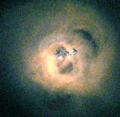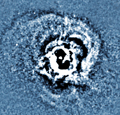Disclaimer: This material is being kept online for historical purposes. Though accurate at the time of publication, it is no longer being updated. The page may contain broken links or outdated information, and parts may not function in current web browsers. Visit chandra.si.edu for current information.
How an X-ray Telescope Detected Sound Produced by a Black Hole
September 16, 2003 ::
The hot gas in the Perseus cluster is very useful for tracing the power of the supermassive black hole at the center of the cluster, and for studying the growth of the large central galaxy. The observational challenge to astronomers is that the 50 million degree gas is only detectable with X-ray telescopes. Early X-ray telescopes, with less advanced optics, struggled to detect structure in the cluster gas, especially near the central black hole. Now the much sharper vision of the Chandra X-ray Observatory has revealed beautiful structures in the cluster gas, culminating in the recent report, by British astronomers, of evidence for sound waves generated by the supermassive black hole in the cluster’s central galaxy.
Sound is generated when an object makes a disturbance in a medium. Examples include vibrations from our vocal chords, from a tuning fork or from a membrane in a stereo speaker. In the Perseus galaxy cluster, scientists believe that sound is generated in the following way: cavities or bubbles in the cluster gas are blown out by jets from a supermassive black hole (located at the center of the cluster). These cavities eventually push against the cluster gas like a piston, generating a pair of sound waves which travel away from the now slowly traveling cavities.
[View the animation]
Note on Octaves
|
How is the Chandra X-ray Observatory able to detect these sound waves?
As mentioned above, the gas that pervades the Perseus cluster is very
hot, and glows in X-rays. If the gas is directly visible, then pressure
waves, if they are large enough, will also be visible, as "ripples" in
the cluster gas. This is what is happening in the Perseus cluster. Scientists
are able to see the sound waves, rather than hear them. By contrast, sound
waves are not seen in the earth's atmosphere because our eyes are only
sensitive to light at optical wavelengths, and air is much too cool to
glow at these wavelengths. If air is invisible, the pressure waves (sound)
passing through it will also be invisible.
Although the sound waves in the Perseus cluster are moving rapidly, the
distance to the cluster is so large (250 million light years) that the
motion of the waves is undetectable from Earth
What type of sound is being generated by the black hole?
If sound waves are produced at fixed, regular time intervals, then a tone, or note is created, similar to the production of musical notes with a tuning fork. The frequency (or pitch) of the note depends on the size of the tuning fork: a small tuning fork moves more rapidly, generating a closely spaced set of sound waves, corresponding to a high frequency note. A larger tuning fork moves more slowly generating more widely spaced pressure waves and a lower frequency note.
Because the cavities in the Perseus cluster are so large, the scale of the sound waves generated is colossal. But, a single cavity from the black hole only produces a single sound wave. The regular spacing of sound waves visible in the top right of the cluster shows that cavities have been generated by the black hole at regular intervals. Knowing the speed of sound plus the measured distance between waves allowed the scientists to estimate the interval between waves at just under 10 million years, corresponding to a frequency of about one cycle per 300 million million seconds, about 57 octaves below B-flat above middle C.
The sound waves provide a critical source of energy for keeping the cluster
gas from cooling too much
and prevent massive amounts of star formation in the central galaxy. Scientists
have calculated that the pitch and intensity of the sound generated by
the black hole would have had to have been roughly constant for about
2.5 billion years to offset cooling due to X-radiation.
Disclaimer: This material is being kept online for historical purposes. Though accurate at the time of publication, it is no longer being updated. The page may contain broken links or outdated information, and parts may not function in current web browsers. Visit chandra.si.edu for current information.






